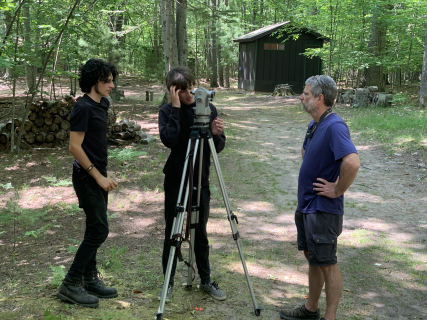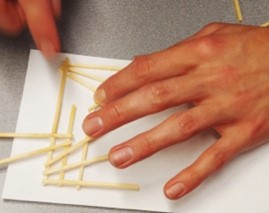

Learning That Works Like the Real World
Waldorf education prepares graduates with a range of skills and knowledge for finding creative solutions to complex problems. We achieve that through teaching and learning that is hands-on, project-based, and interdisciplinary. Children learn to apply their math through games and physical constructs, to explore the laws of physics through field experiments, and to use their artistic abilities to convey their understanding of different subjects. In this way, academics gain context and meaning for children. Students discover that learning is a lifelong pursuit that continues well beyond the classroom. They develop a fascination with the world around them, with how things work, and with how to put their skills and talents to creative use in the world.
The below post, originally published by the American University School of Education in October 2023, discusses the value of the approach of “interdisciplinary education” , which mirrors many of the long-standing principles of Waldorf Education.
In traditional education, students learn in a siloed format in which each subject is taught independently from the others. Although math, science, language arts, and social studies may appear in the same curriculum, the lesson plan of one course usually has no relation to the other courses.
Interdisciplinary education is different. An alternative form of student learning, it reforms the traditional education model by combining subjects to address complex problems that can’t be solved using only one discipline. For example, when analyzing national political poll numbers, students must draw upon their combined knowledge of math, geography, and social studies.
The goal of interdisciplinary education is to shape well-rounded individuals who can think critically and solve problems that span multiple disciplines. Teachers who have completed an advanced degree program understand the value and the benefits that an interdisciplinary education yields.
 Interdisciplinary Education Defined
Interdisciplinary Education Defined
Interdisciplinary education is a method of teaching and learning that combines multiple subjects to create a new line of thinking and address complex problems. This method accomplishes two things that the traditional method of education does not. First, it expands the learning experience by drawing upon multiple subjects at the same time. Second, it promotes critical thinking by encouraging students to engage in complex problem solving.
According to the Science and Research Institute at Carleton College, interdisciplinary learning teaches students the four following cognitive skills.
- Recognizing biases
- Thinking critically
- Embracing ambiguity
- Analyzing ethical concerns
The Challenges of Interdisciplinary Education
Interdisciplinary education is not the traditional format for teaching and learning. Much of that can be explained by the various challenges educators face when implementing it. Teachers who wish to offer their students this type of education must:
- Become sufficiently knowledgeable in each discipline they plan on teaching
- Find the right balance and level of complexity for the subjects they plan to teach
- Convince the student body that interdisciplinary education is a worthy pursuit
- Remain objective and open to other opinions and viewpoints
- Promote the synthesis of ideas from multiple disciplines
- Refrain from offering too much guidance during lessons, as it may interfere with students’ critical thinking and problem solving
- Practice effective classroom management to keep students calm, organized, and focused on the task at hand
Collectively, the challenge of interdisciplinary education is that it requires students and teachers to invest additional time and effort while remaining open minded about the learning model.
 The Benefits of Interdisciplinary Education
The Benefits of Interdisciplinary Education
Although implementing interdisciplinary education poses its challenges, the array of short- and long-term benefits make it a worthwhile endeavor. In addition to learning essential cognitive skills that are valued in professional environments, the interdisciplinary method of teaching and learning can yield the following benefits for students.
- They can explore a wider range of topics.
- They are capable of understanding multiple viewpoints.
- They can objectively evaluate conflicting perspectives.
- They are capable of forming their own ideas and opinions.
- They can utilize the knowledge of multiple disciplines at once.
- They can confidently approach complex problems.
- They gain a more comprehensive worldview.
Many companies list “outside the box thinker” as one of the ideal traits they’re looking for in a job candidate. However, people who think outside the box are usually those who have received an interdisciplinary education. Their cognitive training to think critically, creatively, and beyond the boundaries of a single subject enables them to approach problems and leverage knowledge in ways most people can’t.
Examples of Interdisciplinary Education
Interdisciplinary education draws from several subjects that are presented in concert to facilitate the learning process. For example, the evolution of Japanese cinema requires knowledge of history, a foreign language and culture, and the art of filmmaking. Since era and culture directly influence artistic expression, the interdisciplinary approach to teaching Japanese cinema is the most appropriate.
Yojimbo, released in 1961, depicts the feudal Japanese era when ronin—samurai without a master—are bodyguards for hire. The film directly influenced A Fistful of Dollars, which is a ‘Spaghetti Western’ remake that was released in 1964, starring Clint Eastwood. In terms of interdisciplinary education, comparisons between Eastern and Western culture, film genres, and historical accuracy could all be explored.
Another example of interdisciplinary learning can teach students how to determine probability using genetic conditions that occur in certain dog breeds. Students would need to draw on their knowledge of both mathematics and science to correctly determine the likelihood of a certain breed developing respiratory issues or other healthcare problems.
For example, pugs are 54 percent more likely to develop brachycephalic obstructive airway syndrome (BOAS) compared to non-pug breeds. When students research the anatomical factors that make pugs most susceptible to BOAS, they will discover the breed has an enlarged tongue, elongated soft palate, and narrow nostrils, all of which can lead to breathing issues. Further, students will discover that pugs have DNA mutations, which are reported to be the source of BOAS. The combination of math, canine anatomy and health issues, and molecular structure all play a role in demonstrating the advantage of interdisciplinary education.
